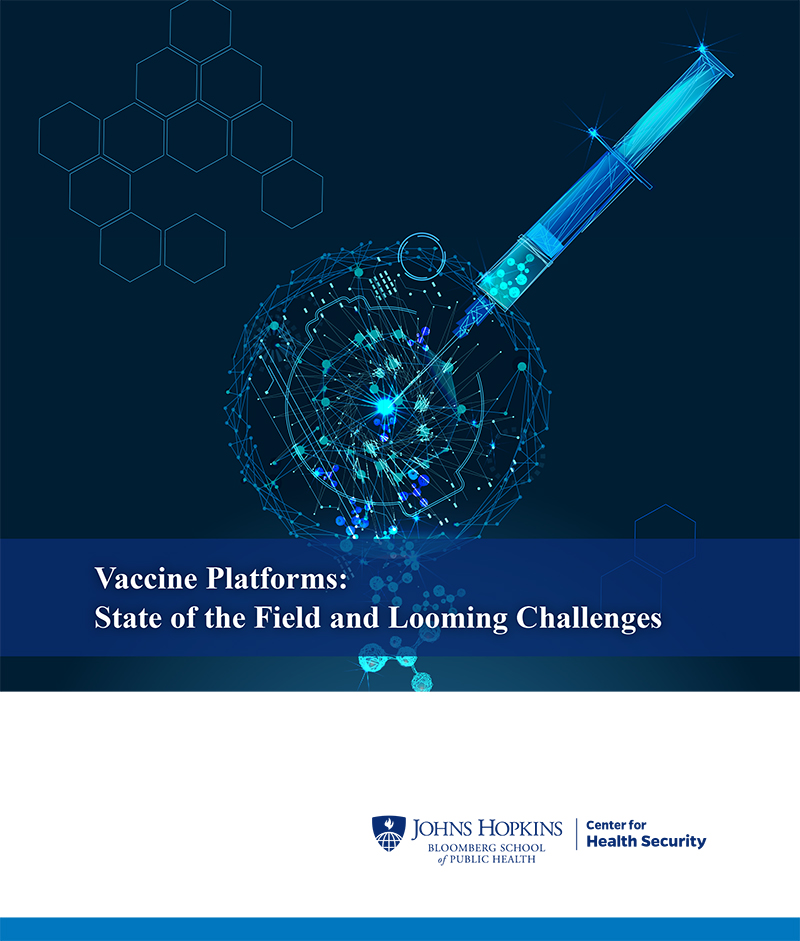Center for Health Security report reviews the promise and challenges of vaccine platform technologies
Center News

April 25, 2019 – To date, the pharmaceutical response to emerging infectious diseases and bioterrorism has been characterized by a “one bug, one drug” approach, where specific medical countermeasures—effective vaccines and therapeutics—are developed, manufactured, and deployed, explain experts in a new report from the Johns Hopkins Center for Health Security. However, over the past several years, platform technologies have been developed that could make it possible for multiple vaccines to be more rapidly produced from a single system.
In the report, Vaccine Platforms: State of the Field and Looming Challenges, released today, the researchers describe major scientific and policy issues related to vaccine platforms and how they are understood in government, academia, and industry. Amesh A. Adalja, MD, a senior scholar at the Center, who led the project team, said that “platforms have the potential to accelerate the vaccine development timeline and the work in this report will hopefully catalyze the discussion of how the power of platform vaccine technologies can be harnessed as a pandemic tool.”
Developing a conceptual understanding of various vaccine platform technologies, with special attention to how they may speed development of vaccines for global catastrophic biologic risks (GCBRs) and emerging infectious disease outbreaks, is critical. The authors write that “as pandemic preparedness matures, the integration of nascent vaccine platform technologies into emerging infectious disease medical countermeasure development has the potential to have a significant impact on human resilience to both GCBR-level and other scales of epidemic threats.”
The report summarizes key findings from existing evidence, informational interviews, and learnings from a workshop that convened subject matter experts. It provides recommendations aimed at helping realize the potential benefits of vaccine platform technologies. Based on the research findings, the project team recommends:
- Vaccine technology proliferation, platform or nonplatform, should be the goal.
- The assessment of how a given platform-based vaccine will accelerate development timelines should not be primarily focused on the expectation for new regulatory streamlining, but more on the basis of acceleration of manufacturing.
- Traditional vaccine development should and will continue to play a critical role in vaccinology alongside platform-based approaches.
- Place a high priority on mRNA-based vaccine techniques that appear particularly promising in terms of ease of manufacture, adaptability to various targets, and biological delivery.
- Platform vaccine technologies for emerging infectious disease medical countermeasures require special considerations, given market conditions.
Dr. Adalja led the research team which also included Matthew Watson, senior analyst; Anita Cicero, JD, deputy director at the Center; and Tom Inglesby, MD, the Center’s director.
This project was supported by funding from the Open Philanthropy Project and is the most recent addition to the Center’s leading research and scholarship on GCBRs.
About the Johns Hopkins Center for Health Security:
The Johns Hopkins Center for Health Security works to protect people from epidemics and disasters and build resilient communities through innovative scholarship, engagement, and research that strengthens the organizations, systems, policies, and programs essential to preventing and responding to public health crises. The Center is part of the Johns Hopkins Bloomberg School of Public Health and is located in Baltimore, MD.
